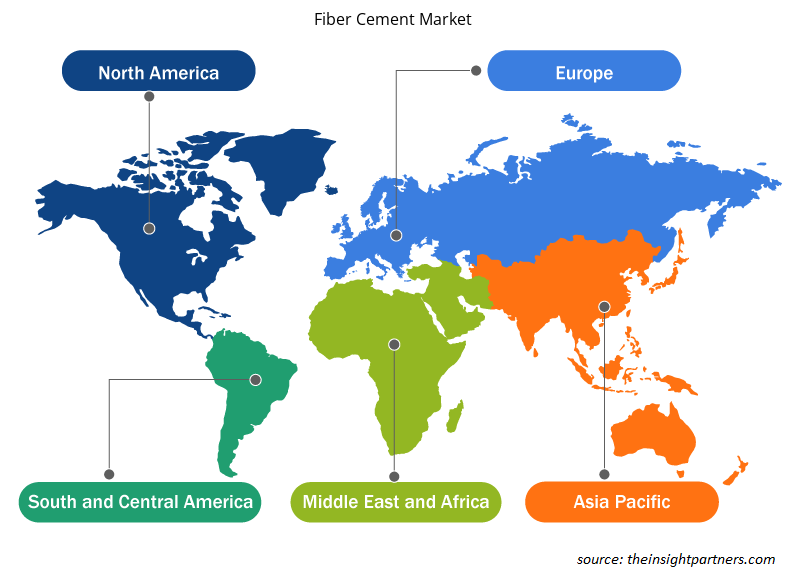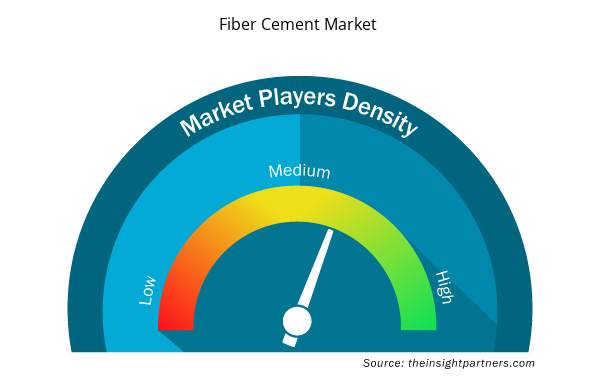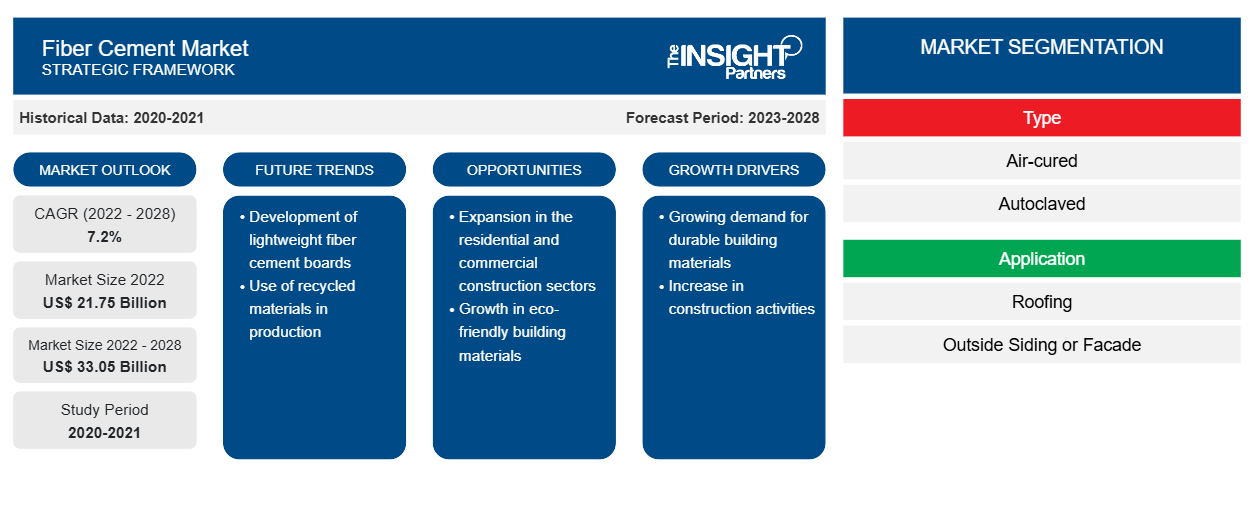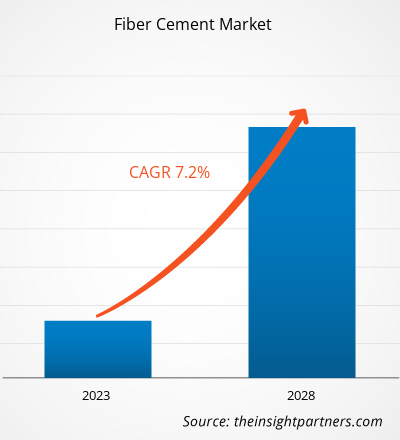[تقرير بحثي] من المتوقع أن ينمو حجم سوق الأسمنت الليفي من 21،748.45 مليون دولار أمريكي في عام 2022 إلى 33،052.23 مليون دولار أمريكي بحلول عام 2028؛ ومن المتوقع أن يسجل معدل نمو سنوي مركب بنسبة 7.2٪ من عام 2022 إلى عام 2028.
تُستخدم الألياف الأسمنتية بشكل شائع كمادة تغطية خارجية لأنها توفر متانة ممتازة ومقاومة للطقس والحرائق. بالإضافة إلى ذلك، تُستخدم الألياف الأسمنتية غالبًا كمادة تسقيف نظرًا لقدرتها على تحمل الظروف الجوية القاسية، مثل الأمطار الغزيرة والبرد والرياح. علاوة على ذلك، يمكن أيضًا استخدام الألياف الأسمنتية في أعمال التشطيب والواجهات، حيث يسهل تشكيلها ويمكن طلائها أو صبغها لتتناسب مع المظهر الخارجي للمبنى. كما تُستخدم بشكل متكرر في المباني التجارية، مثل المستشفيات والمدارس والمباني المكتبية، لأنها توفر خيارًا متينًا منخفض الصيانة للواجهات الخارجية.
في عام 2022، استحوذت منطقة آسيا والمحيط الهادئ على أكبر حصة من الإيرادات في سوق الأسمنت الليفي العالمي . يتزايد الطلب على الأسمنت الليفي في منطقة آسيا والمحيط الهادئ بسبب الوعي المتزايد بشأن فوائد الأسمنت الليفي. وقد لوحظت هذه المنطقة كواحدة من الأسواق البارزة لاستخدام ألواح الأسمنت الليفي بسبب الارتفاع في أنشطة البناء. علاوة على ذلك، تشجع المبادرات والسياسات الحكومية مثل Make-in-India على إنشاء مصانع تصنيع مختلفة في الهند. كما تؤدي الاستثمارات الأجنبية المباشرة المتزايدة إلى النمو الاقتصادي في المنطقة. ومن المتوقع أن يؤدي العدد المتزايد من استخدامات ألواح الأسمنت الليفي في العديد من القطاعات السكنية وغير السكنية إلى زيادة الطلب على ألواح الأسمنت الليفي في منطقة آسيا والمحيط الهادئ في السنوات القادمة. في الهند، تعد صناعة البناء ثاني أكبر صناعة بعد الزراعة، حيث تمثل حوالي 11٪ من الناتج المحلي الإجمالي للبلاد. تعد صناعة البناء والتشييد مساهمًا قويًا في نمو السوق.
قم بتخصيص هذا التقرير ليناسب متطلباتك
ستحصل على تخصيص لأي تقرير - مجانًا - بما في ذلك أجزاء من هذا التقرير، أو تحليل على مستوى الدولة، وحزمة بيانات Excel، بالإضافة إلى الاستفادة من العروض والخصومات الرائعة للشركات الناشئة والجامعات
- احصل على أهم اتجاهات السوق الرئيسية لهذا التقرير.ستتضمن هذه العينة المجانية تحليلاً للبيانات، بدءًا من اتجاهات السوق وحتى التقديرات والتوقعات.
تأثير جائحة كوفيد-19 على سوق الأسمنت الليفي
كان قطاع البناء المساهم الرئيسي في الطلب على الأسمنت الليفي. أثرت جائحة كوفيد-19 سلبًا على نمو قطاع المواد الكيميائية والمواد وسوق الأسمنت الليفي. أثر تنفيذ التدابير لمكافحة انتشار فيروس كورونا المستجد سلبًا على نمو العديد من الصناعات. تأثرت صناعات مثل التعبئة والتغليف والسلع الاستهلاكية والسيارات والنقل والمنسوجات والبناء والتشييد سلبًا بالاضطرابات في الكفاءة التشغيلية وسلاسل القيمة بسبب الإغلاق المفاجئ للحدود الوطنية والدولية. خلال جائحة كوفيد-19، أدى انخفاض الإيرادات وزيادة تحديات تسليم المشاريع إلى انكماش القطاع في معظم الأسواق، مع تأثير سلبي مماثل على القوى العاملة. واجه البناة تأخيرات وزيادة تكاليف المواد الخام المستوردة ومواد البناء خارج الموقع بسبب إغلاق العديد من المصانع لفترات طويلة. أعاق الضرر الذي لحق بصناعة البناء والتشييد الطلب على الأسمنت الليفي أثناء الوباء.
رؤى السوق
الطلب المتزايد على المباني الموفرة للطاقة يعزز نمو سوق الأسمنت الليفي
وفقًا لبرنامج مساعدة إدارة قطاع الطاقة، يتم استهلاك ما يقرب من ثلث الطاقة العالمية في المباني السكنية والعامة والتجارية لتبريد المساحات والتدفئة والتهوية والطهي والتبريد والإضاءة وتسخين المياه وتشغيل الأجهزة الكهربائية والميكانيكية. إن تحديث المدن في البلدان النامية وزيادة دخل الفرد يدفعان إلى استخدام الطاقة في المباني في جميع أنحاء العالم. يخلق الاستهلاك المرتفع للطاقة في المباني العامة والسكنية والتجارية حاجة لتوفير الطاقة. وفقًا لوكالة الطاقة الدولية، من المتوقع أن تمثل المباني حوالي 41٪ من إمكانات توفير الطاقة العالمية بحلول عام 2035، وسيستحوذ القطاع الصناعي وقطاع النقل على 24٪ و 21٪ على التوالي. يتم وضع طبقة من الأسمنت الليفي على المبنى لتقليل انتقال الحرارة عبر الجدران، مما يحافظ على دفء الداخل في الشتاء وبرودة في الصيف، مما يساعد على تقليل استهلاك الطاقة. وفقًا لدليل أساسيات ASHRAE ، فإن الأسمنت الليفي له قيمة R تبلغ 0.15، وهي أفضل من قيمة الطوب والحجر.
رؤى النوع
بناءً على النوع، ينقسم سوق الأسمنت الليفي العالمي إلى معالج بالهواء ومعقم بالبخار. احتل قطاع التعقيم بالبخار حصة سوقية أكبر في عام 2022. يُصنع الأسمنت الليفي المعقم بالبخار من خليط من الأسمنت والرمل وألياف السليلوز ومواد مضافة أخرى. يتم تشكيل الخليط في صفائح أو ألواح ثم معالجته في وعاء ضغط عالي يطبق الحرارة والبخار على المادة. تسبب عملية التعقيم بالبخار تفاعلًا كيميائيًا يقوي المادة، مما يجعلها أكثر متانة ومقاومة للماء والحرائق والآفات. يستخدم بشكل عام في مجموعة واسعة من التطبيقات، بما في ذلك التسقيف والجوانب والأرضيات وكدعامة للبلاط السيراميك . علاوة على ذلك، يُعرف الأسمنت الليفي المعقم بالبخار أيضًا بتنوعه ومرونته في التصميم، حيث يمكن تصنيعه لتقليد مظهر مواد البناء الأخرى، مثل الخشب أو الحجر. كما أنه متوفر بألوان وملمس مختلفين، مما يجعله خيارًا شائعًا لكل من مشاريع البناء السكنية والتجارية.
تعد شركة James Hardie Industries plc وEtex NV وSwisspearl Group AG وCSR Ltd وNICHIHA Corp وPlycem Construsistemas Costa Rica SA وCompagnie de Saint Gobain SA وCentury Plyboards Ltd وEverest Industries Ltd وIsam Khairi Kabbani Group من اللاعبين الرئيسيين العاملين في سوق الأسمنت الليفي العالمي. يركز اللاعبون في السوق على توفير منتجات عالية الجودة لتلبية طلب العملاء. كما يتبنون استراتيجيات مثل الاستثمار في أنشطة البحث والتطوير وإطلاق منتجات جديدة.
تقرير يسلط الضوء على
- اتجاهات الصناعة التقدمية في سوق الأسمنت الليفي لمساعدة اللاعبين على تطوير استراتيجيات فعالة طويلة الأجل
- استراتيجيات نمو الأعمال التي تتبناها الأسواق المتقدمة والنامية
- التحليل الكمي لسوق الألياف الأسمنتية من 2020 إلى 2028
- تقدير الطلب العالمي على الاسمنت الليفي
- تحليل القوى الخمس لبورتر لتوضيح فعالية المشترين والموردين العاملين في الصناعة
- التطورات الأخيرة لفهم سيناريو السوق التنافسي
- اتجاهات السوق وتوقعاتها، فضلاً عن العوامل التي تدفع وتكبح نمو سوق الأسمنت الليفي
- المساعدة في عملية اتخاذ القرار من خلال تسليط الضوء على استراتيجيات السوق التي تدعم المصلحة التجارية، مما يؤدي إلى نمو السوق
- حجم سوق الأسمنت الليفي في مختلف العقد
- نظرة عامة مفصلة وتقسيم السوق، بالإضافة إلى ديناميكيات صناعة الأسمنت الليفي
- حجم سوق الأسمنت الليفي في مختلف المناطق مع فرص نمو واعدة
رؤى إقليمية حول سوق الأسمنت الليفي
لقد قام المحللون في Insight Partners بشرح الاتجاهات والعوامل الإقليمية المؤثرة على سوق الأسمنت الليفي طوال فترة التوقعات بشكل شامل. يناقش هذا القسم أيضًا قطاعات سوق الأسمنت الليفي والجغرافيا في جميع أنحاء أمريكا الشمالية وأوروبا ومنطقة آسيا والمحيط الهادئ والشرق الأوسط وأفريقيا وأمريكا الجنوبية والوسطى.

- احصل على البيانات الإقليمية المحددة لسوق الأسمنت الليفي
نطاق تقرير سوق الأسمنت الليفي
| سمة التقرير | تفاصيل |
|---|---|
| حجم السوق في عام 2022 | 21.75 مليار دولار أمريكي |
| حجم السوق بحلول عام 2028 | 33.05 مليار دولار أمريكي |
| معدل النمو السنوي المركب العالمي (2022 - 2028) | 7.2% |
| البيانات التاريخية | 2020-2021 |
| فترة التنبؤ | 2023-2028 |
| القطاعات المغطاة | حسب النوع
|
| المناطق والدول المغطاة | أمريكا الشمالية
|
| قادة السوق وملفات تعريف الشركات الرئيسية |
|
كثافة اللاعبين في السوق: فهم تأثيرها على ديناميكيات الأعمال
يشهد سوق الأسمنت الليفي نموًا سريعًا، مدفوعًا بالطلب المتزايد من المستخدم النهائي بسبب عوامل مثل تفضيلات المستهلكين المتطورة والتقدم التكنولوجي والوعي المتزايد بفوائد المنتج. ومع ارتفاع الطلب، تعمل الشركات على توسيع عروضها والابتكار لتلبية احتياجات المستهلكين والاستفادة من الاتجاهات الناشئة، مما يؤدي إلى زيادة نمو السوق.
تشير كثافة اللاعبين في السوق إلى توزيع الشركات أو المؤسسات العاملة في سوق أو صناعة معينة. وهي تشير إلى عدد المنافسين (اللاعبين في السوق) الموجودين في مساحة سوق معينة نسبة إلى حجمها أو قيمتها السوقية الإجمالية.
الشركات الرئيسية العاملة في سوق الأسمنت الليفي هي:
- شركة جيمس هاردي للصناعات المحدودة
- إيتكس إن في
- مجموعة سويس بيرل ايه جي
- شركة المسؤولية الاجتماعية للشركات المحدودة
- شركة نيتشيها
إخلاء المسؤولية : الشركات المذكورة أعلاه ليست مرتبة بأي ترتيب معين.

- احصل على نظرة عامة على أهم اللاعبين الرئيسيين في سوق الأسمنت الليفي
السوق العالمية للأسمنت الليفي
بناءً على نوع الألياف، يتم تقسيم سوق الأسمنت الليفي العالمي على أساس النوع والتطبيق والاستخدام النهائي. بناءً على النوع، يتم تقسيم سوق الأسمنت الليفي العالمي إلى معالج بالهواء ومعقم بالبخار. بناءً على التطبيق، يتم تقسيم سوق الأسمنت الليفي إلى تسقيف وجوانب خارجية أو واجهات وغيرها. بناءً على الاستخدام النهائي، يتم تقسيم سوق الأسمنت الليفي إلى سكني وغير سكني.
نبذة عن الشركة
- شركة جيمس هاردي للصناعات المحدودة
- إيتكس إن في
- مجموعة سويس بيرل ايه جي
- شركة المسؤولية الاجتماعية للشركات المحدودة
- شركة نيتشيها
- Plycem Construsistemas كوستاريكا SA
- شركة سان جوبان
- شركة سنشري بلي بورد المحدودة
- شركة ايفرست للصناعات المحدودة
- مجموعة عصام خيري قباني
- التحليل التاريخي (سنتان)، السنة الأساسية، التوقعات (7 سنوات) مع معدل النمو السنوي المركب
- تحليل PEST و SWOT
- حجم السوق والقيمة / الحجم - عالميًا وإقليميًا وقطريًا
- الصناعة والمنافسة
- مجموعة بيانات Excel



Report Coverage
Revenue forecast, Company Analysis, Industry landscape, Growth factors, and Trends

Segment Covered
This text is related
to segments covered.

Regional Scope
North America, Europe, Asia Pacific, Middle East & Africa, South & Central America

Country Scope
This text is related
to country scope.
الأسئلة الشائعة
Asia Pacific accounted for the largest share of the global fiber cement market. Asia Pacific is one of the most significant regions for the fiber cement market owing to surging demand for energy-efficient buildings.
Durability is one of the most desirable qualities of fiber cement. Fiber cement siding, boards, and panels typically outlast vinyl siding and other alternative products in lifespan. Within 10 to 15 years, vinyl siding can show signs of aging, whereas fiber cement siding can last up to 30 to 50 years or more. Further, in cement production, carbon dioxide is a byproduct. However, manufacturing vinyl siding containing polyvinyl chloride (PVC) produces more carbon dioxide than cement production. Hence, fiber cement siding is a greener alternative to vinyl siding. Fiber cement products do not require frequent repainting as it holds paint well. Also, they do not dent unlike steel siding. Fiber cement products stand stronger in moisture and leaks than gypsum boards. These products possess excellent moisture-absorbing and drying properties, making them resistant to weather changes.
Based on type, autoclaved segment held the largest revenue share owing to the its durability and resistance to water, fire, and pests.
Based on the application, roofing segment is projected to grow at the fastest CAGR over the forecast period. Fiber cement roofing sheets and tiles are popular for their durability, resistance to weathering, and low maintenance requirements. They are also available in a variety of colors and styles to suit multiple architectural requirements and design preferences.
According to the World Bank, across the world, a large proportion of the population lives in cities. In 2011, 52.0% lived in urban areas. Over the last ten years, owing to urbanization in developing economies in Asia and Oceania, the urbanization rate increased from 43.3% in 2011 to 50.0% in 2021. Africa has seen a 4.6% increase in the same period. Governments of various countries across the world focus on supporting and increasing construction activities. Saudi Arabia launched its Saudi Vision 2030 to diversify its economy, modernize its administration, and introduce bold reforms in many sectors. The country is targeting to increase the contribution of its construction sector to the overall GDP. Due to its Saudi Vision 2030, the country's construction market reports significant growth in residential and nonresidential segments and offers lucrative potential to fiber cement.
The major players operating in the global fiber cement market are James Hardie Industries plc, Etex NV, Swisspearl Group AG, CSR Ltd, NICHIHA Corp, Plycem Construsistemas Costa Rica SA, Compagnie de Saint Gobain SA, Century Plyboards Ltd, Everest Industries Ltd, and Isam Khairi Kabbani Group.
The List of Companies - Fiber Cement Market
- James Hardie Industries plc
- Etex NV
- Swisspearl Group AG
- CSR Ltd
- NICHIHA Corp
- Plycem Construsistemas Costa Rica SA
- Compagnie de Saint Gobain SA
- Century Plyboards Ltd
- Everest Industries Ltd
- Isam Khairi Kabbani Group
The Insight Partners performs research in 4 major stages: Data Collection & Secondary Research, Primary Research, Data Analysis and Data Triangulation & Final Review.
- Data Collection and Secondary Research:
As a market research and consulting firm operating from a decade, we have published and advised several client across the globe. First step for any study will start with an assessment of currently available data and insights from existing reports. Further, historical and current market information is collected from Investor Presentations, Annual Reports, SEC Filings, etc., and other information related to company’s performance and market positioning are gathered from Paid Databases (Factiva, Hoovers, and Reuters) and various other publications available in public domain.
Several associations trade associates, technical forums, institutes, societies and organization are accessed to gain technical as well as market related insights through their publications such as research papers, blogs and press releases related to the studies are referred to get cues about the market. Further, white papers, journals, magazines, and other news articles published in last 3 years are scrutinized and analyzed to understand the current market trends.
- Primary Research:
The primarily interview analysis comprise of data obtained from industry participants interview and answers to survey questions gathered by in-house primary team.
For primary research, interviews are conducted with industry experts/CEOs/Marketing Managers/VPs/Subject Matter Experts from both demand and supply side to get a 360-degree view of the market. The primary team conducts several interviews based on the complexity of the markets to understand the various market trends and dynamics which makes research more credible and precise.
A typical research interview fulfils the following functions:
- Provides first-hand information on the market size, market trends, growth trends, competitive landscape, and outlook
- Validates and strengthens in-house secondary research findings
- Develops the analysis team’s expertise and market understanding
Primary research involves email interactions and telephone interviews for each market, category, segment, and sub-segment across geographies. The participants who typically take part in such a process include, but are not limited to:
- Industry participants: VPs, business development managers, market intelligence managers and national sales managers
- Outside experts: Valuation experts, research analysts and key opinion leaders specializing in the electronics and semiconductor industry.
Below is the breakup of our primary respondents by company, designation, and region:

Once we receive the confirmation from primary research sources or primary respondents, we finalize the base year market estimation and forecast the data as per the macroeconomic and microeconomic factors assessed during data collection.
- Data Analysis:
Once data is validated through both secondary as well as primary respondents, we finalize the market estimations by hypothesis formulation and factor analysis at regional and country level.
- Macro-Economic Factor Analysis:
We analyse macroeconomic indicators such the gross domestic product (GDP), increase in the demand for goods and services across industries, technological advancement, regional economic growth, governmental policies, the influence of COVID-19, PEST analysis, and other aspects. This analysis aids in setting benchmarks for various nations/regions and approximating market splits. Additionally, the general trend of the aforementioned components aid in determining the market's development possibilities.
- Country Level Data:
Various factors that are especially aligned to the country are taken into account to determine the market size for a certain area and country, including the presence of vendors, such as headquarters and offices, the country's GDP, demand patterns, and industry growth. To comprehend the market dynamics for the nation, a number of growth variables, inhibitors, application areas, and current market trends are researched. The aforementioned elements aid in determining the country's overall market's growth potential.
- Company Profile:
The “Table of Contents” is formulated by listing and analyzing more than 25 - 30 companies operating in the market ecosystem across geographies. However, we profile only 10 companies as a standard practice in our syndicate reports. These 10 companies comprise leading, emerging, and regional players. Nonetheless, our analysis is not restricted to the 10 listed companies, we also analyze other companies present in the market to develop a holistic view and understand the prevailing trends. The “Company Profiles” section in the report covers key facts, business description, products & services, financial information, SWOT analysis, and key developments. The financial information presented is extracted from the annual reports and official documents of the publicly listed companies. Upon collecting the information for the sections of respective companies, we verify them via various primary sources and then compile the data in respective company profiles. The company level information helps us in deriving the base number as well as in forecasting the market size.
- Developing Base Number:
Aggregation of sales statistics (2020-2022) and macro-economic factor, and other secondary and primary research insights are utilized to arrive at base number and related market shares for 2022. The data gaps are identified in this step and relevant market data is analyzed, collected from paid primary interviews or databases. On finalizing the base year market size, forecasts are developed on the basis of macro-economic, industry and market growth factors and company level analysis.
- Data Triangulation and Final Review:
The market findings and base year market size calculations are validated from supply as well as demand side. Demand side validations are based on macro-economic factor analysis and benchmarks for respective regions and countries. In case of supply side validations, revenues of major companies are estimated (in case not available) based on industry benchmark, approximate number of employees, product portfolio, and primary interviews revenues are gathered. Further revenue from target product/service segment is assessed to avoid overshooting of market statistics. In case of heavy deviations between supply and demand side values, all thes steps are repeated to achieve synchronization.
We follow an iterative model, wherein we share our research findings with Subject Matter Experts (SME’s) and Key Opinion Leaders (KOLs) until consensus view of the market is not formulated – this model negates any drastic deviation in the opinions of experts. Only validated and universally acceptable research findings are quoted in our reports.
We have important check points that we use to validate our research findings – which we call – data triangulation, where we validate the information, we generate from secondary sources with primary interviews and then we re-validate with our internal data bases and Subject matter experts. This comprehensive model enables us to deliver high quality, reliable data in shortest possible time.


 احصل على عينة مجانية لهذا التقرير
احصل على عينة مجانية لهذا التقرير